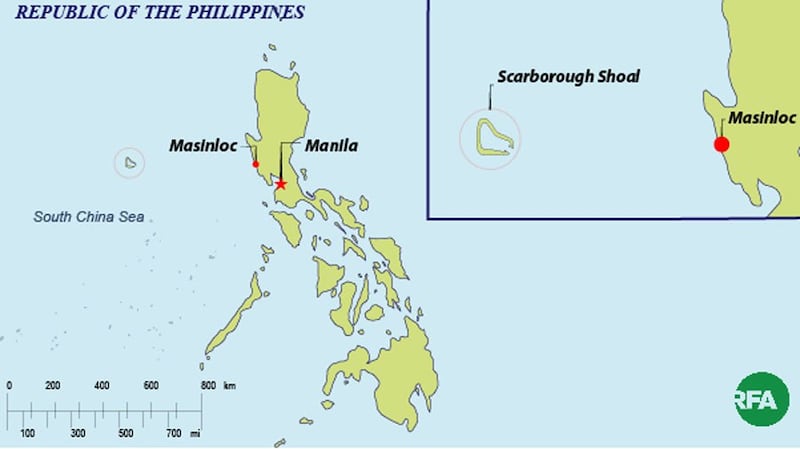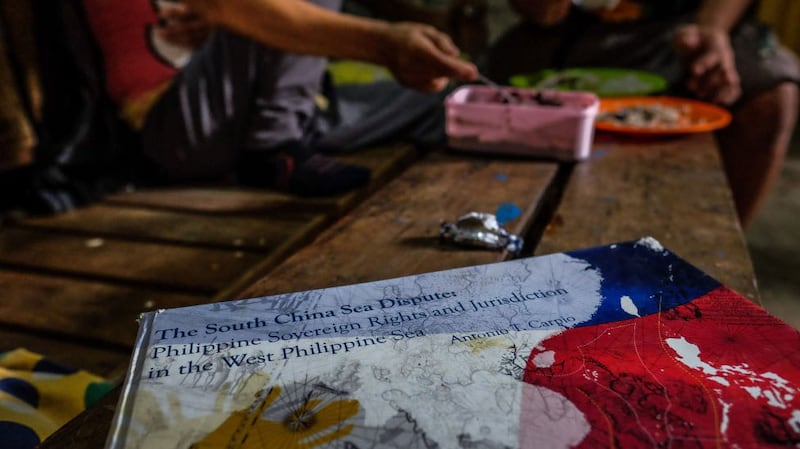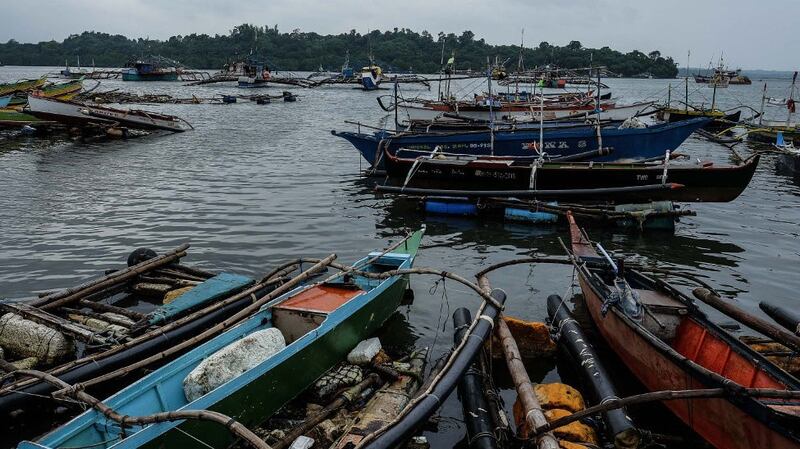Stormy weather, gouty joints and a health scare have temporarily grounded boat captain Johnny Sonny Geruela in Masinloc, a small Philippine fishing community on the frontline of a territorial dispute and international tensions over the South China Sea.
The loquacious father of four, who just recovered from a mild stroke, has been assisting his wheelchair-bound wife and tending to the family’s side business, a pool hall that caters to other grounded fishermen.
“It has been storming, so we can’t go too far out at sea,” said Geruela, 49, who was feeding his wife a pork-blood stew as he spoke to BenarNews, an RFA-affiliated online news service,at his home in Masinloc last week.
“But even if there was no rain, we still can’t go in Karburo just like that. Yes, it is ours, but the Chinese are there, you see.”
He was using the Filipino name for Scarborough Shoal, a triangle-shaped chain of reefs and rocks that lies within the Philippines’ exclusive economic zone (EEZ) in the South China Sea.
Geruela and other fishermen from Masinloc said they hauled in bountiful catches from the rich fishing grounds around the shoal, until Chinese actions there in recent years limited their access to it.
“It used to be that we ate lobsters while fishing there. It was so easy to catch them. And the take-home pay was enough for us after you deduct all the expenses,” he said. “But now, what can we do? I am just an ordinary fisherman like most of us here.”
Geruela has worked as a fishermen for the past two decades, a difficult but rewarding job that practically financed his two older children’s university educations, he said.
But since the Chinese took over Scarborough Shoal, the catches have diminished, he said.
An international arbitration court ruled in favor of Manila in July 2016 and rejected Beijing’s claim to the shoal, but China has ignored the ruling.
Beijing had effectively seized control of the territory, forcing then-President Benigno Aquino to take China to the U.N.-backed Permanent Court of Arbitration in The Hague. His successor, Rodrigo Duterte, who took office in 2016, has not actively pushed China over the dispute and has since sought billions of dollars in Chinese aid and investment.

‘The shoal is ours’
Geruela said government lawyers once visited the fishermen in Masinloc to brief them about the ruling, which cemented what he described as age-old knowledge – that the shoal, which has provided for generations of people here through its fishing ground, belonged to his country.
The officials gifted Geruela a book by Philippine Supreme Court judge Antonio Carpio that compiled the legal arguments and the arbitration court’s final ruling in the landmark case.
The hardcover book sat on a bench that doubled as a dining table for Geruela and his wife. Geruela eyed the tome between spoonfuls of rice and pork-blood stew.
“None of us has read that,” he told Benar, pointing to the book. “Does it have to be that thick to say what we already know? The shoal is ours. It has always been ours.”
“If our president was not able to do anything about Scarborough, what do you expect us to say to the Chinese?” Geruela said.
There have been instances where the Chinese coast guard chased Filipino fishermen away from waters around Scarborough Shoal, or boarded their vessels to get their catch, he said. But such incidents have lessened significantly during the past year, probably because the local media was actively reporting about the dispute, he said.
On one occasion, Geruela said, Chinese coast guard men aboard a rubber boat angrily confronted a Philippine boat, telling the Filipinos to “go away” in an aggressive manner.
He said Philippine fishermen had also seen Chinese fishermen destroying the corals inside the shoal, a worrying sign of times to come because large fish use it as a habitat.
“They are destroying our traditional fishing ground,” he said. “The time will come when the whole area will be destroyed. And all of us, including the Chinese fishermen, will be the losers.”

Damage more costly than aid
For recently married boat captain Ronald Rama, 23, the presence of the Chinese in a Philippine maritime area has added to the woes of his country’s fishing industry, which has seen a steady drop in catches over the years.
While his usual fishing route does not take him to Scarborough Shoal, Rama steers a Filipino-flagged vessel that could be at the mercy of the Chinese, he said.
In June, a Chinese vessel rammed a Filipino fishing boat in Reed Bank, another territory in the South China Sea that lies within the Philippine exclusive economic zone. The Chinese crew left 22 Philippine fishermen stranded at sea, until a passing Vietnamese boat rescued them.
News of the incident provoked near-daily protests in Manila that forced President Duterte to raise the territorial issue with Chinese leader Xi Jinping when he visited Beijing in late August.
“But the president has said that the Chinese have insisted that the entire sea is theirs,” Rama told BenarNews. “As long as they keep the peace, I guess.”
A fisherman’s group called Pamalakaya, which has actively joined anti-China protests, warned earlier this month that environmental damage being wrought in the South China Sea by Chinese activities would end up costing the Philippines more than the soft loans from China that Duterte had boasted about.
The 2016 ruling by the Permanent Court of Arbitration said that China was responsible for about 99 percent of the overall damage to coral reefs in the maritime region, Pamalakaya noted.
“The Philippines will greatly benefit if we would charge China the amount of coral reefs that it destroyed in the West Philippine Sea compared to the unfair loan deals that would put the nation and the people at a disadvantage,” Pamalakaya director Fernando Hicap said, using the Philippine name for the South China Sea.
“Our coral reefs in the West Philippine Sea have dwindled due to Chinese reclamation and destructive harvesting practices, including shallow dredging to extract our precious giant clams,” he said.
The damage caused by the Chinese would “have a long-term and strategic negative impact” on the country’s fish production and the 3 million or so fishermen and others who depend on the sea for their livelihood, he added.
China’s so-called “nine-dash line” covers more than three million square kilometers (1.1 million square miles), roughly 85 percent of the South China Sea, the previous Philippine government had argued before the court.
This claim basically gives Beijing a lock on the sea region, through which U.S. $5.3 trillion worth of the world’s trade passes.
The United States has repeatedly said that it backs the Philippines and other countries in the South China Sea, and warned that it would continue to carry out “freedom of navigation” trips as well as overflights in the region.
China, meanwhile, has kept expanding islands in its possession and building artificial ones. Recently, Beijing installed missiles on military bases in the maritime region that are capable of hitting the Philippines, according to security experts.
Aside from China and the Philippines, Malaysia, Vietnam, Brunei and Taiwan have contending territorial claims in the sea region.

‘If they are here, we feel safe’
In Masinloc, Geruela’s eldest son, Faith, has returned to the area to help his parents.
The 24-year-old had finished a marine engineering degree in Manila, worked for a while as an apprentice in a tugboat but left that job to join his father in his hometown in Zambales province.
On days when the fishing boats are grounded, Faith helps run the pool hall, where fishermen converge to while away the hours as they wait for stormy weather to pass. When BenarNews visited Masinloc, more than two months had gone by since the fishermen last set sail.
“Now is a good time to fish because U.S. ships are constantly in the area, making the Chinese move away,” Faith said with a smile. “Whenever they see Americans, they stay away.”
He said that on a recent fishing trip, he earned about 8,000 pesos (U.S. $154 dollars). That was when the fishermen could not get near Scarborough. But when the Chinese left for a while sometime in June, he said he earned thousands more.
He said that the Chinese had kept their distance in April when a U.S. assault ship was sent to join exercises with Philippine forces, as well as in August, when the aircraft carrier USS Ronald Reagan visited Manila for a routine port trip.
“If they are here, we feel safe,” he said.
Reported by BenarNews, an RFA-affiliated online news service.
